|
Diodes By John Hewes |
| |
||||
| |
Control your Meccano models (or anything else) from your Windows PC!
Take a look at my new MECControl project at meccontrol.com
|
|
 |
Diodes allow electricity to flow in only one direction. The arrow of the circuit symbol shows the direction in which the current can flow. Diodes are the electrical version of a valve and early diodes were actually called valves.
Forward Voltage Drop
Electricity uses up a little energy pushing its way through the diode, rather like a person pushing through a door with a spring. This means that there is a small voltage across a conducting diode. It is called the 'forward voltage drop' and is about 0.7V for all normal diodes which are made from silicon. The forward voltage drop of a diode is almost constant whatever the current passing through the diode so they have a very steep characteristic (current-voltage graph), as shown in figure 1.
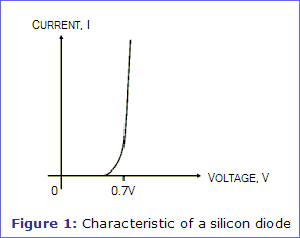
Reverse Voltage
When a reverse voltage is applied a perfect diode does not conduct, but all real diodes leak a very tiny current of a few μA or less. This can be ignored in most circuits because it will be very much smaller than the current flowing in the forward direction. However, all diodes have a maximum reverse voltage (usually 50V or more) and if this is exceeded the diode will fail and pass a large current in the reverse direction; this is called 'breakdown'.
Ordinary diodes can be split into two types:
- Signal Diodes can pass low currents of 100mA or less.
- Rectifier Diodes can pass high currents.
In addition, there are also Light Emitting Diodes (LEDs) and Zener diodes (discussed later in this article).
| Related Articles | Light Emitting Diodes (LEDs) - Detailed information about LEDs |
Connecting and Soldering Diodes
Diodes must be connected the correct way round, and circuit diagrams may be labelled 'a' or '+' for anode and 'k' or '-' for cathode (yes, it really is 'k', not 'c', for cathode!). The cathode is marked by a line painted on the body of the diode. Diodes are labelled with their code in small print, and you may need a magnifying glass to read this on small signal diodes! Figure 2 shows the orientation of two common diodes, the 1N4148 and the 1N4001.
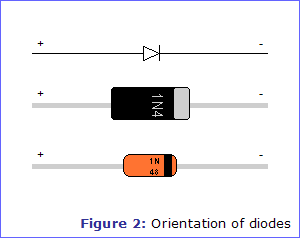
Small signal diodes can be damaged by heat when soldering, but the risk is small unless you are using a germanium diode (codes beginning OA...) in which case you must place a heatsink, such as a crocodile clip, on the lead being soldered. Rectifier diodes are quite robust and no special precautions are needed for soldering them.
Signal Diodes (low current)
Signal diodes are used to process information (electrical signals) in circuits, so they are only required to pass small currents of up to 100mA. General purpose signal diodes such as the 1N4148 are made from silicon and have a forward voltage drop of 0.7V.
Germanium diodes such as the OA90 have a lower forward voltage drop of 0.2V and this makes them suitable to use in radio circuits as detectors which extract the audio signal from the weak radio signal.
For general use, where the size of the forward voltage drop is less important, silicon diodes are better because they are less easily damaged by heat when soldering, they have a lower resistance when conducting, and they have very low leakage currents when a reverse voltage is applied.
Protection Diodes for Relays
Signal diodes are also used with relays to protect transistors and integrated circuits from the brief high voltage produced when the relay coil is switched off.
Figure 3 shows an example of how a protection diode is connected across the relay coil - note that the diode is connected 'backwards' so that it will normally not conduct. Conduction only occurs when the relay coil is switched off, since at this moment current tries to continue flowing through the coil and it is harmlessly diverted through the diode. Without the diode no current could flow and the coil would produce a damaging high voltage 'spike' in its attempt to keep the current flowing.
| Further Information | Relays |
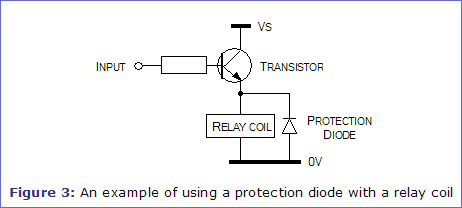
Rectifier Diodes (high current)
Rectifier diodes are used in power supplies to convert alternating current (AC) to direct current (DC), a process called 'rectification'. They are also used elsewhere in circuits where a large current must pass through the diode.
All rectifier diodes are made from silicon and therefore have a forward voltage drop of 0.7V. The table shows maximum current and maximum reverse voltage for some popular rectifier diodes. The 1N4001 is suitable for most low voltage circuits with a current of less than 1A.
Bridge Rectifiers
There are several ways of connecting diodes to make a rectifier to convert AC to DC. The bridge rectifier is one of them and it is available in special packages containing the four diodes required. Bridge rectifiers are rated by their maximum current and maximum reverse voltage. They have four leads or terminals: the two DC outputs are labelled '+' and '-', the two AC inputs are labelled '~'.
The operation of rectification circuits are discussed in detail in the article The Rectifier.
| Further Information | The Rectifier |
Zener Diodes
|
|
 |
Zener diodes are used to maintain a fixed voltage. They are designed to 'breakdown' in a reliable and non-destructive way so that they can be used in reverse to maintain a fixed voltage across their terminals. Figure 4 shows how they are connected, with a resistor in series, to limit the current.
Zener diodes can be distinguished from ordinary diodes by their code and breakdown voltage which are printed on them, as shown in figure 5. Zener diode codes begin BZX... or BZY...
Their breakdown voltage is printed with V in place of a decimal point, so 4V7 means 4.7V for example. Zener diodes are rated by their breakdown voltage and maximum power. The minimum voltage available is 2.7V. Power ratings of 400mW and 1.3W are common.
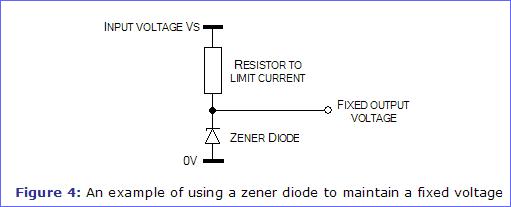
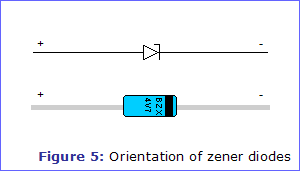
 Shopping List
Shopping List
Part
DescriptionQuantity
RequiredRapid
CodeUnit
PriceTotal
Price1N4001 Rectifier Diode 1 47-3130 £0.11 £0.11 1N4148 Signal Diode 1 47-3416 £0.02 £0.02 Grand Total £0.13
Order the above items from Rapid Electronics via our Circuits Shop and help support the Electronics in Meccano website, without affecting the price you pay! Just click on an item for information about it and/or to add it to your Rapid order.
Orders can also be placed by telephoning Rapid on 01206 751 166 or visiting their website at www.rapidonline.com. Prices quoted include VAT at 20%.
|
|
| Article Information |
Top of Page | Homepage | About | Search | Topics | Features | Circuits Shop | yourEiM |
© 1998 - 2025 Tim Surtell |